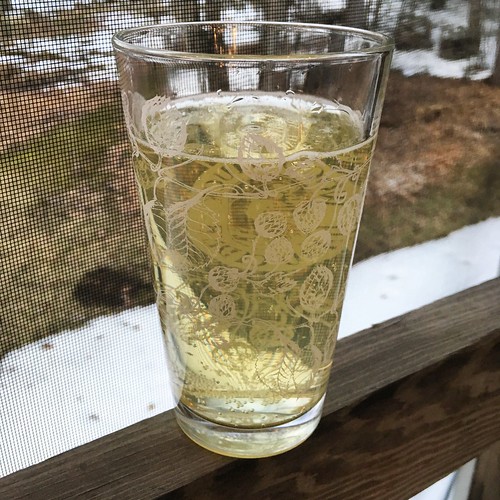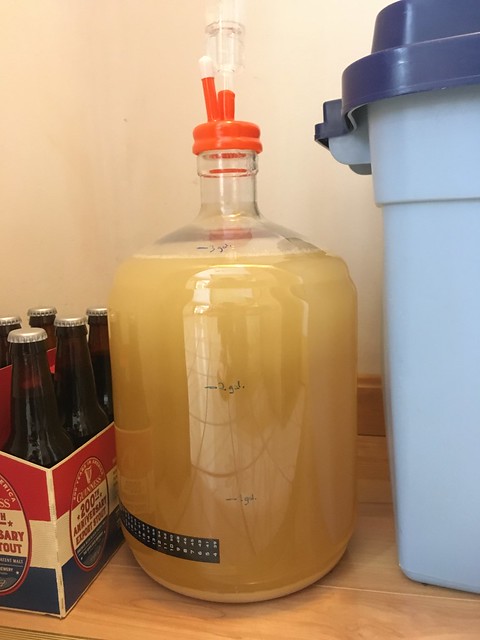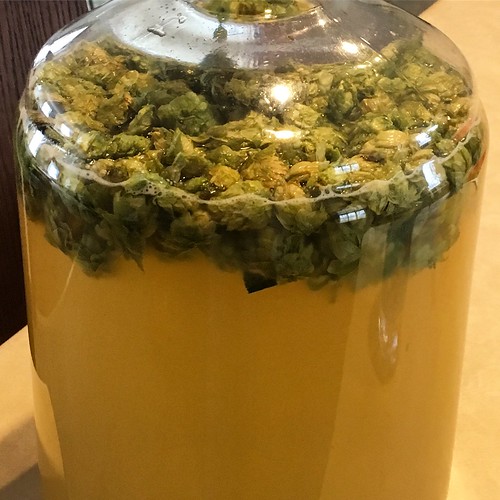Homebrew #53: Kirkland Clover Challenge
¶ by Rob FrieselIt started with an observation that turned into a challenge. Jason noticed you could get 5 lb. of clover honey at CostCo for $11.99 — $2.40 per lb. as opposed to the nationwide average of $7.57 (c. January 2018). Obviously this meant that there was virtually no excuse for any of the club members to try their hand at making a mead. So we started the ExperiMEADal Challenge with the goal of having a bunch club members offer up their first mead entries for the Noonan Competition, and in the meantime… we cross-pollinate and see what different kinds of meads we could manage, all from the same inexpensive source.
I gave mine the descriptive but not terribly creative name: Kirkland Clover Challenge Mead (or just “KC”):
For the benefit of the club’s first-timers, I offered up an as-simple-as-possible 3 gallon starter recipe. And to put my money where my mouth was, I decided that I would — for this batch at least — follow along with those same instructions. (It’s only fair, right?)
Brew Day
A mead “brew” day is almost stupid easy. I collected my gear and ingredients and set up in the kitchen. I crushed 3 Campden tablets and put them in the sanitized carboy. I heated 3 gallons of water to 105°F or so. I put 2 oz. of yeast nutrient into my mixing bucket and ran off 2 gallons of the hot water, stirring the nutrient into solution. I added the 5 lb. of honey, stirring like crazy, to make the must. I topped off the must to make 3 gallons, and then I ran that off into the carboy. I took a gravity reading and had a must at 1.074. 1 The must sat for 24 hours to let the Campden tablets do their thing, then I pitched a single sachet of (rehydrated) Red Star Premier Cuvée.
Believe it or not, that’s pretty much it.
Fermentation
Within about 17 hours or so, I saw activity in the airlock. And though I’d already added 2 oz. of yeast nutrient to the original must, I also decided to experiment with a little bit of staggered nutrients afterward. I added 1.5 g of Fermaid-K at +53 and again at +114 and then again at +151.
About 18 days after pitching, gravity had stabilized at 0.998. On a whim, I decided to dry hop this mead — à la Hop Swarm (née Bitter Bee). I pulled 2 oz. of whole cone Cascade out of the freezer, put them into the carboy, and then racked off the lees and onto the hops.
After seven days on the dry hops, it was time to package. I primed with corn sugar and bottled 22 × 12 oz. bottles. Then I gave them about… two weeks or so to bottle condition.
Overall Impressions
I wouldn’t call it a great mead, but it’s serviceable… drinkable.

AROMA. Mostly the citrusy and floral notes imparted from the Cascade. Very little honey impression.
APPEARANCE. Very pale. Very clear. Fair number of fine, fast-rising bubbles.
FLAVOR. Follows aroma. Moderate citrusy/floral hop flavors. Honey impression is very light, and largely in the background. Clean fermentation characteristics, reminiscent of white wine.
MOUTHFEEL. Light body but not thin. Medium carbonation. Alcohol is in the background but detectable.
OVERALL IMPRESSION. Light and smooth mead with the citrusy/floral hop notes defining its overall profile. Not especially flavorful, but not tasteless either. Refreshing and will be nice to have this option as the weather warms.
That being said, I would say that we learned a couple of things from this experiment. The 5 lb. jug of clover honey from CostCo will make a serviceable mead, but it needs some help in the flavor department (e.g., from other varietals and/or fruit and/or spice etc.). While the honey itself is certified organic, it’s certainly not raw, and almost certainly filtered. In other words, the best compounds from a flavor-contribution perspective have been stripped away. That being said, if you are supplementing with other varietals and/or fruit etc. then this is a relatively inexpensive way to boost the gravity.
Recipe
The recipe for Kirkland Clover Challenge Mead is as follows:
Water Chemistry
Starting with the Champlain Water District profile as a base, add 1 Campden tablet per gallon.
Fermentables
5 lb. Kirkland clover honey
Hop Schedule
2 oz. whole cone Cascade hops (dry hop 5 days)
Yeast
1 sachet Red Star Premier Cuvée
Brew Day
- Collect 10.4 qt. water and heat to 105°F. Pour 2 gallons into a mixing vessel (e.g., PET bottling bucket); add 3 Campden tablets and 2 oz. of yeast nutrient. Stir until dissolved.
- Add 5 lb. clover honey to water. Stir until dissolved. Now you have must.
- Transfer the must from the mixing bucket to the fermenting vessel (e.g., sanitized carboy). Top off with water to achieve 3 gallons.
- Let sit 24 hours for Campden tablets to finish working.
- Aerate the must; pitch Premier Cuvée yeast.
- Start fermentation at 66°F.
Beyond Brew Day
- Allow fermentation to complete (approx. 2-3 weeks) at approx. 64-66°F.
- After achieving final gravity, rack off the lees and onto 2 oz. whole cone Cascade hops.
- Condition on the hops for 5 days.
- Prime with corn sugar and bottle. Let condition at least another 2 weeks.
- Enjoy!
Details
Kirkland Clover Challenge Mead, a dry hopped mead by Tilde Gravitywerks
| Original Gravity | 1.074 |
| Final Gravity | 0.998 |
| ABV | 10.0% |
| Attenuation | 102.9% |
| SRM | 2 |
| Links | Flickr |
- This O.G. being significantly higher than the 1.058 predicted by BeerSmith.[↩]
About Rob Friesel
Software engineer by day. Science fiction writer by night. Weekend homebrewer, beer educator at Black Flannel, and Certified Cicerone. Author of The PhantomJS Cookbook and a short story in Please Do Not Remove. View all posts by Rob Friesel →2 Responses to Homebrew #53: Kirkland Clover Challenge
Pingback: 2018 Brewing Retrospective | found drama




Leave a Reply